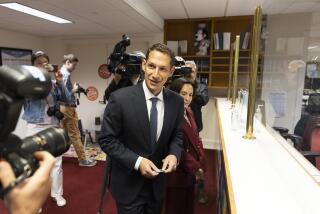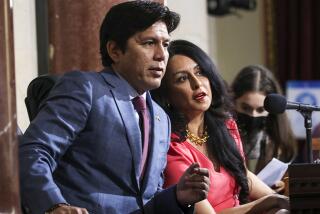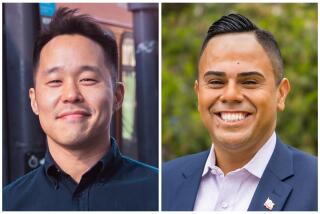Next L.A. Mayor Must Win Valley, Observers Say
- Share via
San Fernando Valley voters can expect to see a lot of Tom Bradley and Zev Yaroslavsky during the next 143 days.
Los Angeles’ mayor or his leading challenger will have to carry the Valley to win the April 11 election, political analysts said. Both candidates, in fact, have already stepped up their visibility in the Valley, which has more than a third of the city’s 3.2 million residents.
“He who carries the Valley will win the election,” said Yaroslavsky, whose Westside district was extended into Sherman Oaks and parts of Van Nuys and North Hollywood in the council’s 1986 redistricting.
Bradley, who political consultants say is no longer assured of heavy Westside support because of his opponent’s roots, must look to the Valley for crucial votes.
3 Valley Visits
The mayor made three visits to the Valley last week, including stopping at a school and appearing at anniversary ceremonies for the Los Angeles Aqueduct in Sylmar. Speaking for Bradley, Deputy Mayor Michael Gage said, “We think every area of the city is key, and we expect to win every area of the city.”
As political analysts see it, Bradley and Yaroslavsky have their strongest bases of support in other parts of the city. Bradley has always done well in South-Central Los Angeles, which he represented as a councilman before his election as mayor in 1973. Yaroslavsky is strongest in his Westside district.
“That leaves the Valley up for grabs,” Los Angeles City Councilwoman Joy Picus said.
The Valley also is prized because it traditionally has had a higher voter turnout than other areas. In the Nov. 8 election, for example, about 70% of middle- to upper-income voters in the West Valley and south Valley went to the polls. In the East Valley, about 67% of voters cast their ballots. The average turnout citywide was 64%.
“The Valley is Zev’s great opportunity,” said former Los Angeles City Councilman Bob Ronka, who lives in the Valley. “The Valley is going to be the deciding factor in the race. It’s critical for Zev to develop his constituency here.”
“It’s where I think the candidates will spend a disproportionate amount of their time and a lot of their campaign dollars,” political consultant Steve Afriat said.
The Valley, which as a whole is more conservative than the rest of the city, has always been tough turf for the liberal mayor. In seven campaigns, including ill-fated runs for governor in 1982 and 1986, Bradley collected a majority of the Valley vote only twice--both times against weak opponents, former Mayor Sam Yorty in 1981 and City Councilman John Ferraro in 1985.
Although he carried the rest of the city, Bradley was badly beaten in the Valley in the 1986 gubernatorial race against George Deukmejian. But Bradley’s handlers note that Deukmejian is a conservative Republican. Yaroslavsky, like Bradley, is a liberal Democrat.
In the Valley, Bradley is more of a “known commodity” than Yaroslavsky, “and in that sense, they’re viewing Bradley as the more conservative of the two,” said Bobbi Fiedler, a former northwest Valley congresswoman.
“Bradley in the last election made a big effort to gain support in the Valley,” Fiedler said.
In the 1985 election, Bradley for the first time carried the northwest Valley’s 12th Council District, the city’s most conservative. The district includes Canoga Park, Chatsworth, Granada Hills and Northridge.
“Obviously, the Valley is an area where Zev is not as well-known as Bradley,” Ronka said.
Westside Backing Questioned
Bradley has proven that he can win without the support of the Valley. But in past elections, Bradley enjoyed strong support on the Westside. That support is no longer assured with Yaroslavsky in the race.
And Yaroslavsky has realized for some time the importance of the Valley to his mayoral aspirations.
Since his district was changed to include Valley territory, he rarely has missed an opportunity to speak out on Valley issues. He has been out in front on the Valley light-rail controversy. He also has proposed a truck ban on the Ventura Freeway, advocated easterly takeoffs at Burbank Airport and opposed a proposed toxic incinerator next to Van Nuys Airport.
Bradley, as he has in past campaigns, will say “the same thing in the Valley that he says everywhere else in the city,” Gage said. “He doesn’t treat any area as a stepchild.”
Interviews with backers of both candidates offered a glimpse into the kind of campaign that is likely to be waged in the Valley.
Yaroslavsky backers are counting on Proposition U to give their man a boost. The 1986 slow-growth initiative that Yaroslavsky co-wrote won overwhelmingly in the Valley. Bradley did not support Proposition U.
In what is likely to be a major theme of his campaign, Yaroslavsky attacked Bradley for not supporting construction of a cross-Valley subway in lieu of an above-ground trolley. The trolley has been opposed by residents living near the proposed rail lines.
Dodo Meyer, Bradley’s Valley deputy, responded that Bradley supports building a light-rail trolley because there isn’t enough money to build a subway from one end of the Valley to the other.
She said Bradley has pushed for construction of a trolley because polls show that a majority of Valley residents want a light-rail line “no matter where it is” located.
As for Yaroslavsky’s criticism of the mayor on the growth issue, Meyer said, “Buildings are still going up in Zev’s district.”
More to Read
Sign up for Essential California
The most important California stories and recommendations in your inbox every morning.
You may occasionally receive promotional content from the Los Angeles Times.











